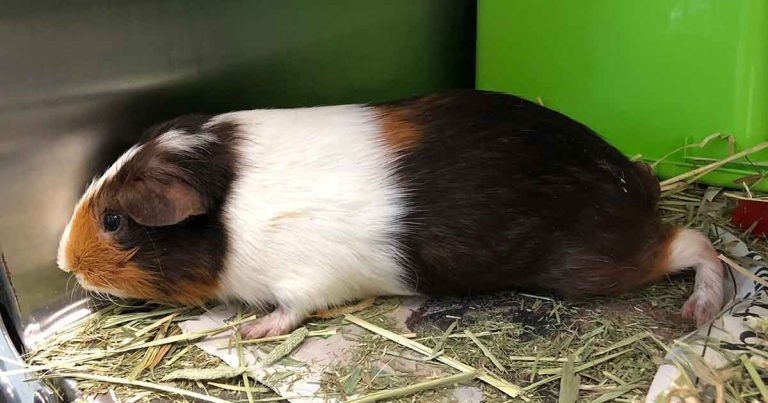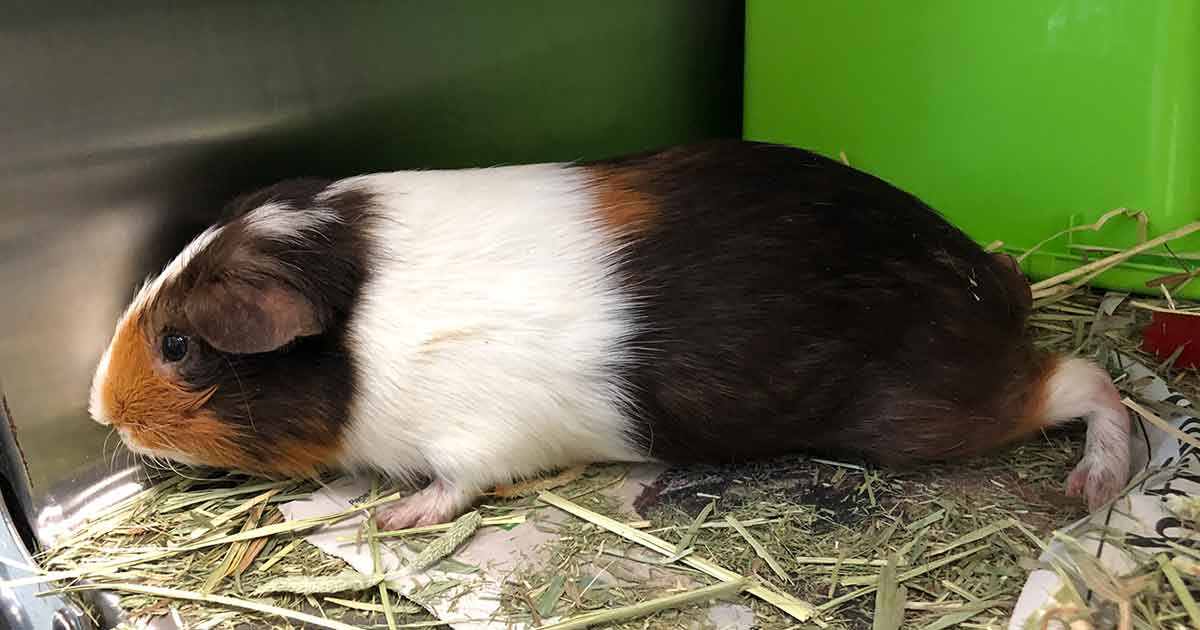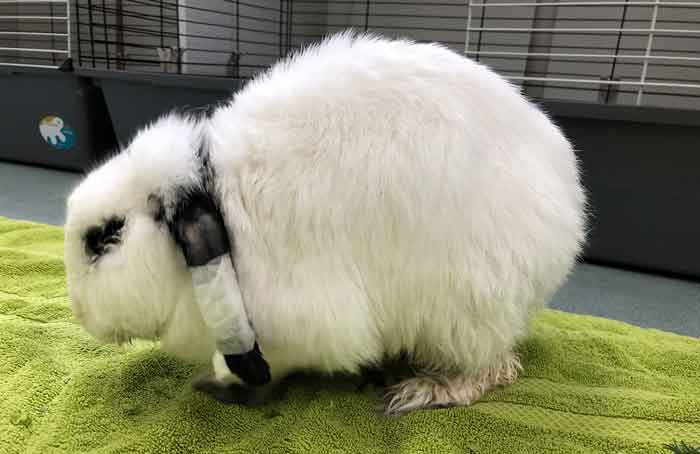15 Apr 2019
Management of pain in small furries: types and protocols
Sonya Miles looks at methods of assessing and managing these symptoms in exotic species.

A picture demonstrating belly pressing behaviour as a result of a liver mass and gastric dilatation-volvulus.

Rabbits, rodents and ferrets are becoming increasingly popular pets (Flecknell, 2001; Wenger, 2012).
With an increase in ownership comes an increase in owner expectation in providing a high standard of pain management (Flecknell, 2001; Barter, 2011). Pain assessment in these less familiar species can be challenging for vets not familiar with working with them (Flecknell, 2001; Hawkins, 2006).
As the majority of exotic mammals are a prey species, they are inclined to hide painful conditions to maintain a normal appearance, therefore avoiding predation (Wenger, 2012; Miller and Richardson, 2010; Balko and Chinnadurai, 2017), and, as such, it is easy for less experienced veterinary practitioners to miss the subtler signs of pain (Miller and Richardson, 2010; Panel 1). Observations for potential signs of pain should be made carefully and quietly, ideally by a single observer (Flecknell, 2001).
- Reduced appetite
- Reduced faecal output
- Increased water intake
- Change in behaviour (aggression)
- Lethargy/exploring the environment less
- Pica
- Limping
- Piloerection
- Weight loss
- Hypothermia
- Squinting
- Increased respiratory rate, heart rate
- Altered posture (hunching/back arching)
- Altered gait
- Self-traumatising/over-grooming a certain area
- Reluctance to move
- Belly pressing
- Twitching/wincing
- Increased porphyrin production
- Lack of grooming (unkept fur)
- Increased blood pressure
- Bruxism
These species undergo the same physiological changes as the more familiar animals, meaning it is unethical not to appropriately analgise them if needed (Barter, 2011).
A survey of small animal practitioners in the UK has shown administration of analgesics to small mammals is less common than in dogs and cats. For example, postoperative analgesics were administered between 50% to 70% of dogs and cats (depending on the nature of the surgery), but only 21% of those surveyed gave analgesics to rodents and rabbits (Flecknell, 2001; Capner et al, 1999; Lascelles et al, 1999).
Pain assessment
No perfect way exists of assessing pain in any animal species, but it is particularly difficult in nocturnal animals (Hawkins, 2006) and, although many pain-scoring methods have been developed, few have been rigorously validated clinically in any species, and none can be applied universally (Hawkins, 2006; Allweiler, 2016; Balko and Chinnadurai, 2017).
A new, potentially useful method of pain assessment is through analysis of facial expressions (Allweiler, 2016). The use of facial expressions has been assessed in mice, rabbits, rats and horses during periods when pain has been induced. Orbital tightening, nose and cheek bulges, and changes in ear and whisker position, have been linked to the presence of pain in rodents (Allweiler, 2016).
Analgesia should be pre-emptive of any noxious stimuli wherever possible (Wenger, 2012; Balko and Chinnadurai, 2017). If this is unavoidable, pain should be treated as soon as possible, before adverse disease effects are noted (Wenger, 2012).
Untreated pain has many undesirable physiological effects, such as an increase of morbidity and mortality or the development of a chronic pain state – all of which can lead to a poor quality of life for the patient or the caregiver (Barter, 2011; Balko and Chinnadurai, 2017).
Multimodal approach
In the author’s opinion, the approach to pain management should, ideally, be multimodal with regards to the pharmaceuticals used, in combination with non-pharmacological methods, such as gentle tissue handling, appropriate surgical technique, hospitalisation, nursing, restraint and even having their bonded companion present for the recovery period.
A multimodal approach combines different classes of analgesics targeting different pain pathways, allowing smaller doses of each drug to be used, as well as 0.25% to 0.5% less inhalant anaesthetic agent, therefore reducing any undesirable affects (Flecknell, 2001; Lichtenberger and Ko, 2007).
NSAIDs inhibit cyclooxygenase (COX) enzymes – COX-1 and COX-2 – which are involved in the production of prostaglandins, part of the inflammatory pathway (Miller and Richardson, 2010). NSAIDs, such as meloxicam and carprofen, are used to treat mild to moderate pain (Barter, 2011; Allweiler, 2016), while also having antipyrexic activity (Barter, 2011). NSAIDs generally have a wide margin of safety when used appropriately and, in rabbits, doses of 1.5mg/kg given orally once daily for five days causes no ill effects (Barter, 2011). Side effects are reported – these include gastrointestinal ulceration, platelet inhibition, as well as hepatic and renal dysfunction (Balko and Chinnadurai, 2017; Allweiler, 2016). NSAIDs are often used alongside opioids, working together with them, resulting in a lower dose of both classes of drugs being used (Barter, 2011).
Opioids are a central component of multimodal analgesia (Lichtenberger and Ko, 2007). They act centrally to limit the input of nociceptive information to the CNS, which reduces central hypersensitivity (Allweiler, 2016). When used correctly, they have a wide margin of safety and effectively alleviate pain (Allweiler, 2016). Common side effects associated with opioid usage include respiratory depression, nausea, gastrointestinal stasis and, occasionally, pica in rats that have been given buprenorphine (Miller and Richardson, 2010; Allweiler, 2016).
Buprenorphine – a partial µ– agonist – is one of the most common opioids used as analgesia for mild to moderate pain in exotic mammals (Lichtenberger and Ko, 2007). It has a slow onset of action, but lasts a relatively long time (Hawkins, 2006), demonstrating no sedative effects in rabbits (Barter, 2011). Buprenorphine has poor oral bioavailability.
This, coupled with a significant hepatic first pass metabolism, means oral administration, compared to parental routes, is of limited value in exotic species (Allweiler, 2016; Hawkins, 2006).
Butorphanol, a mixed agonist-antagonist, has low μ-receptor activity, but a strong k-receptor activity (Hawkins, 2006), making it of questionable analgesia benefit in small mammals (Lichtenberger and Ko, 2007). Due to the ceiling effect caused when giving butorphanol, its use in minor procedures is limited as it often needs to be given at two to four-hour intervals, making it inconvenient and expensive (Lichtenberger and Ko, 2007).
Butorphanol can be used to reverse μ-receptor agonists without reversing the analgesic effects, only any respiratory depression caused by the initial μ-receptor agonist (Lichtenberger and Ko, 2007).
Full μ-receptor agonists include fentanyl and morphine (Lichtenberger and Ko, 2007; Hawkins, 2006). Fentanyl has a short duration of action and, at high doses, can cause respiratory depression (Lichtenberger and Ko, 2007). It is most often used as part of a constant rate infusion allowing its dose to be titrated to affect and decreasing the doses needed for concurrent analgesics or anaesthetics (Lichtenberger and Ko, 2007). Plasma levels vary when administered transdermally, and fentanyl lasts for approximately 30 minutes when given IV (Lichtenberger and Ko, 2007).
Morphine, being intermediately lipid soluble, is most suitable for epidural use (Lichtenberger and Ko, 2007). It is slow to take effect (approximately one hour) and histamine release has been noted in certain species when given IV (Lichtenberger and Ko, 2007).
Tramadol has been anecdotally used in chronic pain cases, with very little evidence to say it actually works. In one study, it was shown to be effective in rats for OA (Hawkins, 2015). Tramadol’s level of efficacy decreases with its duration of use and a variable plasma concentration of the M1 metabolite is produced in exotic mammalia (Hawkins, 2015).
Lidocaine and bupivacaine are the two most commonly used local anaesthetic agents in small mammals (Allweiler, 2016). Bupivacaine has a high potency and a longer duration of action, but a great cardiovascular toxicity and, therefore, should never be given IV when lidocaine can be (Allweiler, 2016).
Local anaesthetics block ion channels, which prevent the generation and conduction of pain impulses (Hawkins, 2006), with overdoses leading to major adverse effects, including CNS toxicosis, cardiovascular collapse and death (Balko and Chinnadurai, 2017). Local anaesthesia can be performed topically, given as local infiltration, peripheral nerve blocks, dental nerve blocks and epidural anaesthesia, in combination with an opioid such as morphine (Barter, 2011; Lichtenberger and Ko, 2007; Allweiler, 2016).
Epidural anaesthesia will provide analgesia within 10 to 15 minutes and lasts at least 60 minutes to 90 minutes when using lidocaine, and 4 to 8 hours when using bupivacaine decreasing the animal’s overall recovery time (Allweiler, 2016). This technique, however, is challenging in rodents (Allweiler, 2016; Lichtenberger and Ko, 2007).

Conclusions
In conclusion, an effective analgesic plan has both pharmacological and non-pharmacological components (Barter, 2011) and, wherever possible, should be multimodal in its approach to target multiple locations within the pain pathway at the same time (Barter, 2011).
Assessing pain in small mammals can be difficult – especially for clinicians not familiar with working with that specific species and even when using pain scoring systems, which are not validated universally for exotic mammal species (Balko and Chinnadurai, 2017).
Providing a suitable, stress-free environment will, in turn, help facilitate the observer’s assessment of signs of pain (Barter, 2011), but it should be noted most small mammals are prey species and will hide signs of pain (Barter, 2011).
References
- Allweiler SI (2016). How to improve anaesthesia and analgesia in small mammals, Vet Clin North Am Exot Anim Pract 19(2): 361-377.
- Balko JA and Chinnadurai SK (2017). Advancements in evidence-based analgesia in exotic animals, Vet Clin North Am Exot Anim Pract 20(3): 899-915.
- Barter LS (2011). Rabbit analgesia, Vet Clin North Am Exot Anim Pract 14(1): 93-104.
- Capner CA, Lascelles BDX and Waterman-Pearson AE (1999). Current British veterinary attitudes to perioperative analgesia for dogs, Vet Rec 145(4): 95-99.
- Carpenter JW (2005). Exotic Animal Formulary (3rd edn), Elsevier Saunders, St Louis.
- Flecknell PA (2001). Analgesia of small mammals, Vet Clin North Am Exot Anim Pract 4(1): 47-56.
- Hawkins MG (2006). The uses of analgesics in birds, reptiles and small exotic mammals, J Exot Pet Med 15(3): 177-192.
- Hawkins MG (2015). Advances in exotic mammal clinical therapeutics, Vet Clin North Am Exot Anim Pract 18(2): 323-337.
- Lascelles BDX, Capner CA and Waterman-Pearson AE (1999). Current British veterinary attitudes to perioperative analgesia for cats and small mammals, Veterinary Record 145(4): 601-604.
- Lichtenberger M and Ko J (2007). Anaesthesia and analgesia for small mammals and birds, Vet Clin North Am Exot Anim Pract 10(2): 293-315.
- Meredith A (2015). BSAVA Small Animal Formulary. Part B: Exotic Pets (9th edn), BSAVA, Gloucester.
- Miller AL and Richardson CA (2010). Rodent analgesia, Vet Clin North Exot Anim Pract 14(1): 81-92.
- Wenger S (2012). Anaesthesia and analgesia in rabbits and rodents, J Exot Pet Med 21(1): 7-16.
